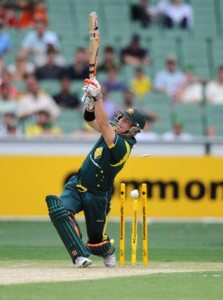
A gradual but inevitable descent into cricket-based loathing and bile.
David Warner, Powerhouse: The Travails Of The Golden Boy Of Australian Cricket
For those of you whose long term memory hasn’t been ruined by excessive consumption of cheap gin, cast your minds back ten months to the first day of the WACA Test match. Australia were hosting India and things were not going well for the tourists. Bundled out for 161 shortly after tea on a pitch that was still littered with bottle caps from the impromptu soiree held on it the night before, it was looking bleak for the holders of the Border-Gavaskar Trophy. And then David Warner arrived.
When recollecting that momentous innings, forget the fact that by this stage the Indian team gave every impression that Perth was the last place in the world they wanted to be (although honestly, who could blame them?). Forget that the only Indian bowler who looked remotely interested, Ishant Sharma, wasn’t introduced for over an hour, by which point the Australian total was already nearing a hundred. Forget even Warner’s extraordinarily leaden footwork that culminated in him deciding it was preferable to start copping bouncers on his head rather than trying to get out of the way of them. Instead remember how Warner, inside a session, took India apart, mostly by hitting the ball a really, really long way, and brought up his century from a mere 69 deliveries. It was a defining moment in Australian Cricket history. Or at least so the Channel 9 commentary team would have had us believe.
Fast forward now to the present. In eight Test match innings since that day Warner averages 25.87, with a top score of 50. His ODI record appears much better, with an average of 35 over the same period. In truth, though, his one day average, much like his Test average (42.1), is artificially boosted by two large totals. In Test cricket it’s the aforementioned century against India plus an admittedly impressive hundred in difficult conditions against New Zealand, whilst in one day cricket it was back to back centuries against Sri Lanka late in the Commonwealth Bank Series. Remove these scores and his averages in Test and ODI cricket over this period plummet to 19.1 and 23.1 respectively. Sure, if you were to deduct all the centuries scored any batsman’s average would suffer – Bradman’s in particular would start to look pretty poor – but what these numbers show is just how hit and miss (mostly miss) Warner has been in his career to date.
It doesn’t take a genius to appreciate that there are real problems with the Australian top order across all three formats, but in Test cricket it’s been fashionable to point the finger at Ed Cowan rather than Warner. In a way, that does make some sense as Cowan, five years Warner’s senior, ought to be responsible for anchoring the innings. Whilst it’s true that Cowan possesses an extremely limited technique, a well-rounded technique is hardly a prerequisite for a successful Test opener. Just look at Alastair Cook. Cowan has struggled to adapt to the mental demands of playing international cricket more than anything, and if he is able to overcome these (and strong performances for the ‘A’ team suggests he might be on his way to doing so) he may, in time, prove a decent Test opener.
Which leaves the question of what to make of Warner, and it is here this article is about to veer into slightly controversial waters. Warner isn’t rubbish. He is far from it. In fact some of us here at 51allout (well, to be completely honest, me) would go so far as to claim that Warner possesses the ability to become a genuine world class Test opener. For those of you who happened to watch the painful exhibition of Warner hopelessly floundering against Pakistani spinners during the Australia series in the UAE, such a claim must appear pathetically deluded. But Warner’s performances to date across the world, admittedly mostly in T20 cricket, indicate that he has almost limitless potential.
Therein, however, lies the problem. If you were to take heed of the opinions emanating from inside the Channel 9 commentary box (not a good idea at the best of times), or, more worryingly, from the Australian support staff or even the man himself, Warner has already made good on his potential and is nearing the finished product. It’s not surprising that Warner takes any opportunity to talk himself up; it’s that sort of bullish confidence that has some suggesting he is future Test captain material. So as misguided as Warner’s claims that the turning wickets in the UAE wouldn’t trouble him seem in retrospect (of his six innings against Pakistan, he was dismissed by spinners five times), it’s pretty much to be expected.
When those sorts of comments come from someone like Australian head coach Mickey Arthur, though, it’s slightly more concerning. Arthur is one of Warner’s biggest fans and directly after that innings at the WACA claimed “he has the ability to lead any Australian team in any form of the game at some stage.” On other occasions Arthur has claimed to not be worried by Warner’s frequent early dismissals, claiming the opener was still “doing a job.” Even more concerning, though, was Arthur’s statement that there was no need to encourage Warner to adopt a more accountable approach to Test cricket in order to deliver more consistently. As strange as it seems, Warner’s hit or miss approach seems to be good enough for the Australian management team.
The concern, for Australian fans at least, is that the hype that surrounds Warner and the advice that he is receiving from within the camp will convince him (not that he is really in need of convincing) that he has already made it in international cricket. Arthur, in particular, frequently praises Warner’s commitment to training, but as of yet there’s been no indication that any effort has been made to prepare Warner better for the demands of Test cricket. To date it seems that Warner’s aggressive approach is destined to pay off just once per series on home turf, and it spectacularly failed altogether in his only away series in the West Indies.
It goes without saying that the South African attack, when they arrive on Australian shores in November, will provide a stern examination of Warner’s ability, or lack therof. And needless to say Australia are doomed at the T20 World Cup if he doesn’t fire there (to be honest, they are doomed anyway). But the real test will arrive when Australia tour India in early 2013 for a four Test series (and probably the usual six million ODI contests). Warner has performed in India before, during the Champions Trophy and IPL, but will obviously find Indian pitches a far different proposition in Test cricket. The tour, therefore, will provide a good opportunity to determine whether Warner will be prepared to adopt a different approach, particularly after the shambles that was his series against Pakistan, or simply follow the path that has proven successful for him in T20 cricket. And after that there is, of course, the small matter of back to back Ashes. And we all know how well Warner played during his last visit to British shores…




No Comments
Post a Comment